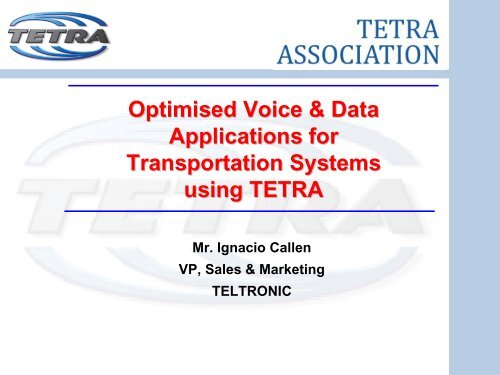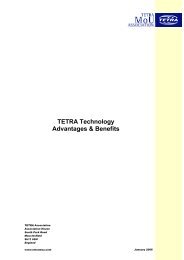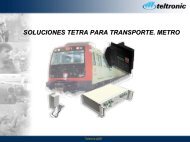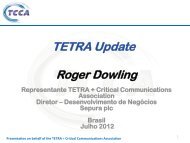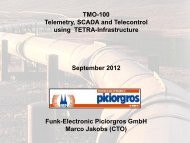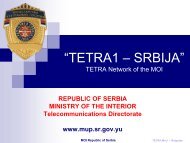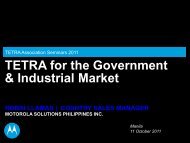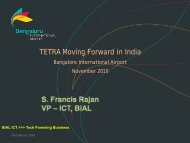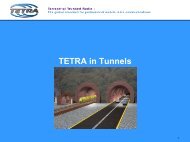Transport Applications - tetra
Transport Applications - tetra
Transport Applications - tetra
Create successful ePaper yourself
Turn your PDF publications into a flip-book with our unique Google optimized e-Paper software.
Optimised Voice & Data<strong>Applications</strong> for<strong>Transport</strong>ation Systemsusing TETRAMr. Ignacio CallenVP, Sales & MarketingTELTRONIC
Contents1. TETRA ADVANTAGES2. TETRA NETWORK MODEL3. BUSES AND TRAMS - OPTI MISING AVLTMB BARCELONA BUSES NETWORK CASE4. PORT TANJUNG PELEPAS NETWORK CASE5. METRO AND RAILWAY APPLICATION MODELTETRA IN AUTOMATED METROSOME REFERENCES6. RAILWAY MODEL7. CONCLUSIONS
TETRA: Advantages Open standard (several suppliers of terminals) Security: Encryption and authentication Ethernet/IP Connectivity Enhanced Data Transmission Capabilities =>Allow to implement ITS applications & voiceusing the same network Simultaneous voice and data support Full duplex communications: hands free Benefits for Surface transport: built-in GPS forAVL Worldwide implemented in <strong>Transport</strong> andPublic Safety
Buses & Trams – Optimising AVL
ONE ONETECHNOLOGYFOR FOR ALL ALLSERVICESPROVIDINGCOST COSTOPTMISATION.Driver &MaintenanceVoice ServicesVehicleSensorsTransmissionLocalisationData (AVL)PassengerinformativepanelsSecuritySystems•Half duplex and full duplex call with Control Centre•Direct connection with PABX & PSTN.•Voice Communications between maintenance personaland Control Centre & Depots.•Status Messages (i.e. start of route indication)•Short Data Message (i.e. sporadic bus data interrogation– Fuel level)• Key Requirement: buses sending its position (GPS) on aperiodic basic.•If not handle correctly can affect to the others service ofthe system.• Controlled by the Control Centre for give information topassengers (i.e. bus stations)• Suitable for Short Data Messages• Emergency pedals or buttons enabling silent ambiencecall from Control Centre.• Alarm triggers allowing communications betweenpassengers and Control Centre.
SunSunNetworkBus / on board systemsRed EthernetSAESAMGPS CPUGateway CAN BusDEPOTSWIFIZonaFrancaIPonentRONDA DELMIGRONDA DELMIGBilling CPUExternal Info PanelsPA system TFTSPVSICSIUSC-WiFiWi-Fi RouterGPRSSC-RadioCPU TETRASEVCPU VideoWifi LinkRONDALITORALRONDALITORALLutxanaFONT FOTOGRAFIA: BARCELONAREGIONAL, S.A.TriangleRONDA DEDALTRONDA DEDALTHortaBUSES COMMAND CENTREBus linkPABXTSCDepot linkFEPTETRA NETWORKPDHSERVERControl Centre LinkGestoSwMI
On-board equipmentBusdriver’sMMIBus driver’saudio systemAudiointerface-PTT- Emergencybutton-Call request- Driver Login PassengerAmbiencelisteningmicrophoneHandsetGPSAntennaHands-freeaudio kitTETRA MSTETRAAntennainformationsystemPEIControl unitcontroldataPANELTelemetrysensorsBillingsystemOtherperipheralsengine,speed,doors...
On-board equipmentControlunitBussysteminterfaceTETRAradioPassengerinformationsystemDriver’s s MMIconsoleMicrospeaker &hands-freemic
Buses & Trams – Optimising AVL• Automatic regulation – Efficiency mostlydepends on the refreshment periods whichcan be achieved• Old analogue systems – Control of radiochannels (PTT-CD signals) by AVL<strong>Applications</strong>• TETRA = TDMA. How to overcome the gapbetween the AVL Application and TETRAtransport layers?
Synchronous Data Manager –How it works• Optimised polling– Polling avoids random access collisions – 100% channel uplink v. 37%under normal circumstances– Synchronous access is achieved by sending a status message askingfor “slot granting”. 20-byte data is sent with the ACK reply to this statusmessage• Multiple secondary control channels (SCCH)/base station- increases capacity• Synchronisation of control channels• Definition of new commands – to manage sequential & cyclical polling lists• SDM is based on the controlled use of a portion of the control channel toavoid the “avalanche” of random access radio collisions
TMB, Barcelona Buses
TMB, Barcelona Buses• Migration from analogue PMR to TETRA• Innovation, applications, coverage• SDM/AVL server application integrated to SAE business modelsoftware:• Each SBS – 20 bytes/bus at a rate of 24 buses/second• Not just data, needs to integrate with voice comms.• Control Centre integration via VoIP• TETRA Dispatcher Protocol (TDP -SIP format–).- Interface withTETRA infrastructure• On-board, AT commands are used over radio’s PEI (PeripheralEquipment Interface)• System integrates buses (special units) and management handportables
PTP Port Tanjung Pelepas, Malaysia
NAVIS-TETRA GatewayVoice (1)Instruction (2)TOSConfirmation (2)SPARCSRadio ServerGPS(3)Voice (1)Instruction (2)Confirmation(2)GPS dataPOSHReal timeLocation (3)TETRAGatewayTETRABASEMDT-400
NAVIS-TETRA Workflow
Functional Overview– TETRA Gateway Server Application• Maintain connection with SPARCS Radio Server• Receiving XMLRDT message through the connection with SPARCS RadioServer• Encapsulate the XMLRDT message and then transmit SDS to MDT-400using N2A.( If encapsulated data is over max SDS size, it divide encapsulation datato send)• Receiving the SDS from NEBULA with N2A• Recode the transmitted data or log– TETRA Terminal(MDT-400)• Shows received SDS message from XMLRDT server• Confirm the received message and send back confirm message
Metro and Railway Application Model
TETRA Network ModelSBS 1SBS 2…SBS n-1SBS nASYNCHRONOUS BACKBONEManagementSystemCentralSwitchIP NetworkISDNAPIATC SystemRadioDispatchersDispatchingCentreAnalog RadioNetwork
Typical requirements in Metro and Railway:• Full and half duplex calls (private and group)• Built-in emergency button• Status and short data• Operational console integrated into the driving dashboard• Interaction with the Passenger Information System• Interaction with the Train Control and Monitoring System (TCMS).• Integration of TETRA and analog communications• Railways – Fulfilling of ETCS Requirements
Functions:• Voice calls to and from the Dispatching Centre• Public addressing and ambience listening• Emergency braking activation• Fire extinguishers activation• Train switch on / switch off• Update of the information panels• Discreete location (beacons)• Update of the TCMS parameters
On Board Subsystems:DisplayLEDCPUIndicatorsMMI ConsoleTecladoAntivandálicoAuxiliaryButtonsCommunications rackVHFAnalogRadioCPUTETRARadioTo the train controlsystem (TCMS)Input/Output LinesMVB Connection (TCNNetwork)MaintenanceTETRA AntennaVHF AntennaHandsetHands freesystemAUDIO INTERFACETo passengerinformation system(addressing)To redundant rack and console
Typical configuration(2 Racks & 2 consoles, up to 200 meters between bothsystems)MMIConsoleTrain Control SystemMMIConsoleCommunications Rack(TETRA + VHF)Communications Rack(TETRA + VHF)
On Board Subsystems:High customisation is required to adapt to:- Different train manufacturers(CAF, Alstom, Siemens, Ansaldobreda, Bombardier, …).- Differente power supply voltages and signalling(+110v DC, +72v DC, +24v DC).- Different operational requirements- Higher MTBF figures- Space available for rack mounting- Several types of interfaces to TCMS (MVB, Ethernet,RS-485, …)- Customized on-board subsystem
Barcelona Subway, Line 9 (Spain)The Barcelona Underground Line 9 is the largestunderground line in whole Europe:• 46.6 Km.• 51 stations• 90 millions passengers per year
Barcelona Subway, Line 9 (Spain)
TETRA in Automated Metros• Security• Exploitation• Maintenance• Can act as an emergency backup ofthe Automatic Train Control (ATC)system
Application ModelCommandsTETRA NetworkOn Board TETRASubsystemTCMSCommandsControl Centre
SDS TL based ProtocolTETRASDS TL ServiceApplication - Control
SDS TL based ProtocolPROTOCOL ID = C0H (ETSI registered)TYPE OF MESSAGE ACK SS STMESSAGE REFERENCE (counter)TEXT SCHEME = 01H (8-bit latin alphabet)PROPIETARY APPLICATION CODECOMMANDTRAIN NUMBER / TYPE OF TRAINCOMMAND PARAMETERS
Security CommandsEMERGENCY BRAKINGTYPES OF COMMANDSBYPASS OF BRAKE / TRACTION LOOPPUBLIC ADDRESSING MESSAGEDISABLE SERVICE BRAKEFIRE DETECTION / FIRE EXTINGUISHERSACTIVATIONDETECT ALARM HANDLE UNATTENDEDDOORS OPEN / CLOSE
Exploitation CommandsTYPES OF COMMANDSTRAIN SWITCH ON / SWITCH OFFTRAIN BIRTH (Number and Type of Train, Driver)EXTERNAL / INTERNAL PANELS CONTENTLIGHTS / MUSIC / VIDEO / CLIMATIZATIONTCMS CONFIGURATION/ DRIVING MODETRAIN LOCATION (SBS or BEACONS)VOICE GROUP CHANGE (SBS or BEACONS)
Maintenance CommandsTYPES OF COMMANDSDIAGNOSIS / REQUEST / SENDING ALARMSTRAIN TIME SETUPPANTOGRAPH UP / DOWNNEUMATIC SUSPENSION DISABLE / ENABLEVOLTAGE INTERRUPTORREMOTE SOFTWARE DOWNLOADING (circuit data)ATP SYSTEM RESET
Example: Start-up Sequence with TL_REPORTCCCTCMSStart UpTL_REPORTAcceptedRADIOStart UpTL_REPORTInitiatedInitiatedTL_REPORTTrain Switched OnTrain Switched OnTL_REPORTCCC = Command & Control CentreTCMS = Train Control & Monitoring System
Example: Start-up Sequence without TL_REPORTCCCTCMSStart UpAcceptedRADIOStart UpInitiatedInitiatedTrain Switched OnTrain Switched OnCCC = Command & Control CentreTCMS = Train Control & Monitoring System
Railway model
TETRA Rail ForumAt the end of 2006, the TETRA association (TETRA MoU)created the TETRA Rail ForumThe goal is to analyse the railways requirements and decidewhether the TETRA’s successful Metro model can be used forthis industry or notOutside Europe TETRA is already a serious alternative toGSM-R; although there are also technological reasons themain one is economical => TETRA requires half the basestations than GSM-R for the same coverage areaNext Steps for the TETRA Rail Forum:– Understand the railway industry requirements– Define the additional supplementary services that might beneeded– Analyse the set of safety standards to be accomplished– Define a roadmap of TETRA for railways applications
Main ETSI Standards of applications in railways Safety related electronic systems for signalling (EN 50129) Software safety (EN 50128)Key Concepts– Safety Case (SC): 6 documents– Safety Integrity Level (SIL): from 1 to 4 (*)– 10-9 < SIL 4 < 10-8– 10-8 < SIL 3 < 10-7– 10-7 < SIL 2 < 10-6– 10-6 < SIL 1 < 10-5TETRA industry has started to apply for SIL certifications according toSafety Cases(*) THR (Tolerable Hazard Rates)
TETRA vs. GSM-R TETRA achieves or improve the voice requirements ofRailways systems (i.e. Call setup < 300 ms) TETRA improve the current data rate (i.e. 19200 bps packetdata rate) TETRA works in 380-470 Mhz, requiring half the base stations(cost effective) TETRA doubles the frequency efficiency (4 channels in 25Khz) TETRA has proven working at 574.8 km/h (ALSTOM, France,2007)
Russian Railways, Moscow-St.Petersburg
Some TETRA References: : Metro and RailwayRUSSIAN RAILWAY – Moscow-St.Petersburg Line, RussiaSIEMENS – Santiago Metro, ChileSIEMENS – Alger Metro, AlgiersSUPERVIA – Rio de Janeiro, BrazilTHALES - Buenavista-Cuautitlán Line, Mexico D.F., MexicoALSTOM – Line 12 Metro, Mexico D.F, MexicoT-SYSTEMS – Nuremberg Metro, GermanyLISBON PUBLIC TRAMS – PortugalTAIPEI METRO - TaiwanBARCELONA UNDERGROUND – Line 9, SpainSAMPOL - Metro de Mallorca, SpainCAF, ANSALDOBREDA, - Metro de Madrid, SpainMETRO MADRID – Línea 2, SpainEFACEC-IKUSI – Tenerife Light Trains, Spain
ConclusionsProfessional Mobile Radio is dominant in transport todayTETRA is the most implemented technologyTETRA has proven to be the most adequate and costeffective technology for AVL, providing efficient voice anddata communications with one communications systemTETRA is suitable to support exploitation in Metros (Manualor Automated)TETRA allows to remotely controls the trains, providingenhanced security, efficiency and cost effectivenessThe new challenge for TETRA industry regarding transportindustry is to be adequate to be the future replacement ofGSM-R systems in Europe and the chosen technology in thenew implementations outside Europe
Thank YouIgnacio Callenlicallen@teltronic.es


